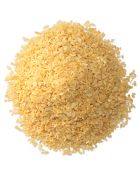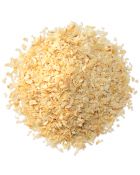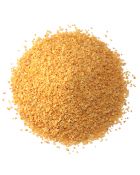
Spices
Market Update
Q1 2024
Dried Onion
US
The 2024 US onion crop is fully planted and progressing normally in most areas. The Imperial Valley crop is nearing maturity, and harvest is scheduled for early May. Overall, industry plantings have reduced by 20-30% over the prior year due to industry destocking, which extended longer than expected. Market segments continue to work down existing inventories because of the high interest rates and costs associated with holding stocks. Grower costs face overall inflation, wage increases, and tight labor availability, with similar factors impacting manufacturing.
California experienced a series of late-season storms with periods of dry, warm conditions; because of this, foliar disease is a concern in some regions. Overall yields could be affected by 1-2%, but it is too early to tell at this time. ofi’s Agriculture Team is closely monitoring the situation and taking the necessary measures to minimize any potential impact on the crop. California’s snowpack is close to normal for this time of year, and most reservoirs are currently at or above historic average levels, which includes beneficial storage from last year. The Bureau of Reclamation water allocation is at 35%, which is below expectations.
California’s Sustainable Groundwater Management Act (SGMA) goes into effect in 2025. This policy has a corresponding cost impact on growers and varies by district and water availability. ofi continues to mitigate the impact of weather and other crop-related factors by diversifying our growing regions across the Western US.
Current inventory levels of US dehydrated onions are sufficient to support core business. Demand for piece fractions, especially chopped and large chopped fractions, and micro-sensitive specifications remain strong with elevated pricing, especially for spot demand. Pricing for next year is expected to mirror inflation. However, the shortfall in fresh market onion in Europe and India has driven up global prices, subsequently affecting the availability of dehydrated onion from offshore markets with correspondingly elevated prices, contributing to a surge in spot demand for dehydrated US onion. The situation is expected to continue through the second half of 2024.
Future Outlook
US
- Harvest for the 2024 onion crop is expected to begin in May.
- Industry acreage is down primarily attributed to destocking.
- There’s a potential for a slight drop in yields due to disease pressures.
- Demand is extremely high for piece fractions and low micro products.
- Grower and processing costs are facing overall inflation, pricing for next year is expected to follow inflation.
Dried Garlic
US
Garlic plantings for crop year 2024 are complete. The crop is progressing close to its planned levels at this time. Harvest is scheduled for late June, with dehydration beginning in early July. Similar to the US onion crop, the intermittent storms throughout California this year could result in a higher level of disease pressure. The impact will be known closer to harvest. Like onion, growers are managing overall inflation, higher wages, and constrained availability of labor. Inventories across most fractions and quality levels are adequate to support demand. Demand remains strong for BI-controlled products and minced garlic; supplies are limited for spot business until the new crop with elevated pricing. As with US onions, garlic contract pricing is projected to keep pace with inflation.




China
Garlic flake prices have increased compared to one month ago, mainly due to the expectation of yield reduction. The total garlic flake production volume of the 2023 crop is much less than the consumption, so the total stock of garlic flake keeps reducing. From the farmer to the buyer, the market is watching closely to see how this year’s crop turns out, and the outcome will affect garlic availability and prices worldwide. The speculation activities have been very hot recently.
Future Outlook
US
- Harvest is expected to begin in June. The US garlic crop could face diseases pressures impacting yields, but it’s too early to tell at this time.
- Demand is very high for BI-controlled products and minced garlic.
- Growers and processors are managing inflation linked costs. Pricing for next is expected to follow inflation.
Chiles
Green Chiles / Organic Green Chiles
Spring crop: The first harvest for the spring crop came off strong. Then, cooler weather settled in the growing area, delaying the maturation of the second harvest. As a result, growers will complete contracted volumes later than anticipated. Summer crop: The first direct seed fields have been planted. Expect continuous planting until mid-May. Spring Weather patterns are normal, and we do not foresee any challenges during planting times.


Jalapeño / Organic Jalapeño
Spring crop: This conventional season is coming to a close, and no shortages are expected for the spring crop as volumes have been substantial. However, there is an expectation that organic jalapeño will come up short due to insect infestation. Additional organic quantities were contracted for the summer pack to offset this loss. Summer crop: Seedlings are emerging in the greenhouses and growing well. The expected transplant dates are scheduled throughout April.
Red Chiles
Contracts are wrapped up for the 2024 season, and at this point, planting is already underway. Weather in the United States growing region for red chiles has been a mixed bag. Winter saw greater-than-normal amounts of moisture, with temperatures not quite as cold as normal. As we’ve moved into planting, we have seen some last impacts from Mother Nature, with cooler temps coming back. The outlook indicates a warming trend is on the way. The market will diligently watch the crops progress through the windy season, and all reports suggest it to be a substantial season for this phenomenon. Similar to Mexico, pricing in the US is still a sensitive topic for both the red and greens as we see some legislative labor initiatives that impact the industry along with much the same elevated input costs. Overall, we are coming off a challenging weather year for the southwest US in 2023(record heat). Despite the obstacles, the industry still feels optimistic about the new year.
Vietnam Spices
Pepper
Vietnam’s harvest started in January and is expected to finish by the end of April. Vietnam and Brazil are expected to see a decline in their production, impacting the global pepper supply. Pepper prices have increased by 30% over the last three months and are currently at the highest level in the previous few years. In the first two months of 2024, Vietnam exports have decreased by 24% compared to YTD 2023. So far, the USA has been the largest destination for Vietnamese pepper imports. Exports to Europe are up by 38% while exports to Asia and the Middle East are down by 62% and 35%, respectively.
Cassia, Nutmeg, & Ginger
Cassia: We expect the spring crop harvest to start by the end of March. In the first two months of 2024, Vietnam exports were down 13% compared to last year. India was the largest import destination; however, the volume was down 32% compared to the same time last year.
Nutmeg: The February harvest has finished. The main harvest is expected to arrive in May or June. There is minimal demand, and prices are stable.
Ginger: An outbreak of fungal disease destroyed Nigeria’s 2023-2024 ginger crop. Due to a supply shortage, prices almost doubled compared to last year. New planting is expected to start in April.
Indian Spices
Cumin
Gujarat acreage increased by 103% compared to last year. Cumin acreage in Jaisalmer and Bikaner in Rajasthan (major IPM growing regions) has increased by 30% from last year. Crop damage in Rajasthan due to blight, high-velocity wind, and unseasonal rain is less than 30%. In Rajasthan, harvest is 40% complete. Export demand has picked up from China at current price levels. Prices were volatile in January and February but corrected in March. NIPM cumin prices are expected to be stable to bearish. IPM cumin prices are expected to be high due to low availability.
Coriander
Gujarat state data on sowing shows a 48% decrease in coriander acreage compared to last year. Traders estimate the reduction to be close to 55%. Madhya Pradesh and Rajasthan acreage has decreased by more than 25%. Harvesting has started in Rajasthan, Madhya Pradesh, and Gujarat. India production in 2023 increased by more than 70% compared to 2022, with vendors carrying a lot of carry-forward stack for the 2024 season. New crop arrivals with less moisture have started in Mandis. Domestic demand for coriander was slow in December, January, and February. Domestic demand picked up from Masala companies in March, which has supported the prices. More production of better-quality grades this year has also helped prices. Prices have been on an uptrend in March even though there is pressure from the arrival of new crops. Coriander prices are expected to be stable to bullish.
Chilli
Chilli prices are trending down from January 2024 to March 2024. Crop arrivals usually end by the second week of May; however, this year, they may end by the third week of April. Currently, deluxe qualities are not available in the market. 70% of arrivals are considered medium to medium best qualities. IPM crop availability is very scarce this year. The intensity and spread of black thrips in Andhra Pradesh and Telangana have increased. Blight and dieback are impacting the estimated yield in the Warangal area.
Turmeric
Turmeric prices have increased slightly from January 2024 to March 2024. Sowing was 25% reduced in 2023, and the total crop is 27% less than last year. Harvesting will be completed in Telangana and South and North Karnataka by the end of March. Tamilnadu and Marathwada harvesting is at its peak. Prime arrivals started from Nizamab, Sangli, and South Karnataka (Gundulpet). Very few farmers are holding stocks in Telangana, North, and South Karnataka. Tamilnadu farmers have shown strong signs of holding stocks for a few months. No rainfall has been reported since January 2024. Besides the Jagatiyal region in Telangana, no damage was reported to harvested crops. Finger quality is considered good in all regions compared to last year.
Shop Spices





